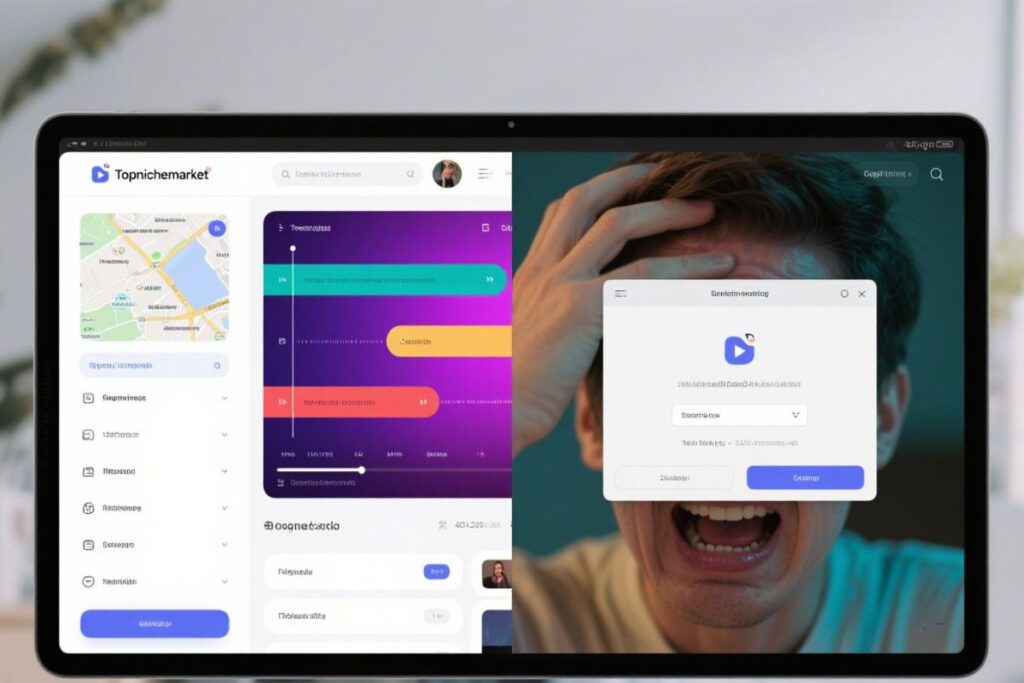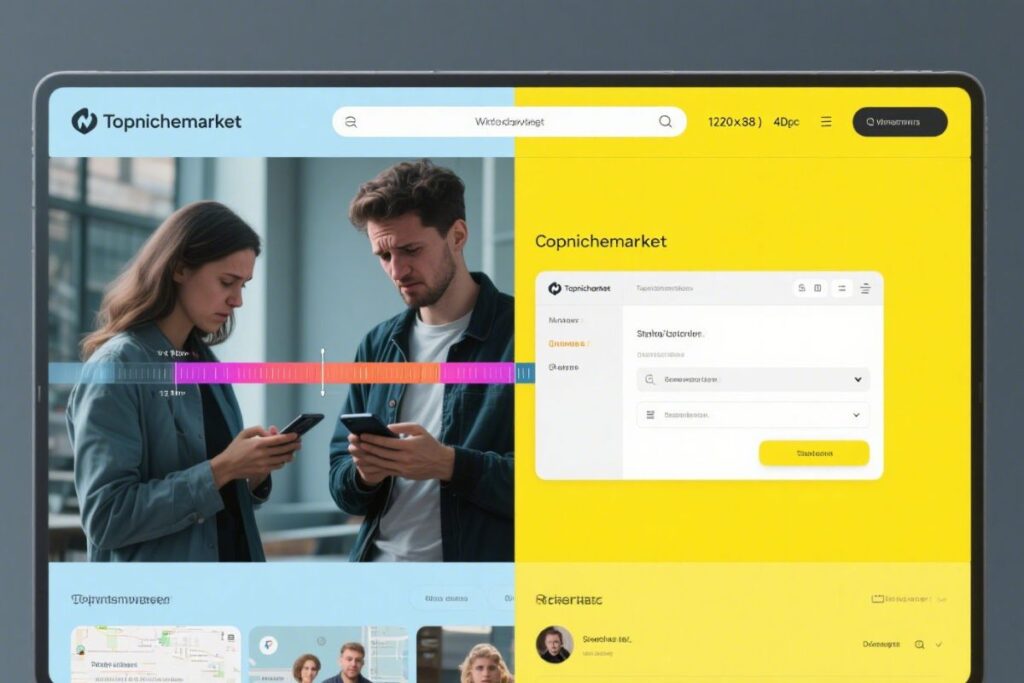Table of Contents
TogglePictory.ai Review 2025: Is This AI Video Generator From Text Worth the Frustration and Performance Problems?

Pictory.ai Review 2025 Is This AI Video Generator From Text Worth the Frustration and Performance Problems
Hello fellow content creators and digital marketers! If you’re like me, you’re constantly seeking innovative ways to make your content resonate, engage your audience, and achieve tangible results. In today’s dynamic digital environment, video content isn’t just a trend; it’s a fundamental requirement. However, crafting compelling, professional-looking videos often demands significant time, specialized skills, and considerable resources, which are luxuries many of us simply don’t possess in abundance.
This is precisely where the exciting prospect of an ai video generator from text or a sophisticated video maker ai steps into the picture. Imagine the efficiency of transforming your existing articles, scripts, or even lengthy videos into impactful short-form content with remarkable speed, perhaps with just a few clicks. It sounds like an ideal solution, doesn’t it? This aspirational vision is precisely what tools like Pictory.ai are designed to deliver upon.
Introduction: What Exactly is Pictory.ai, and Why Are Content Creators Hunting for a New Video Maker?
In the high-speed realm of online content marketing, producing video content has become an essential component, no longer optional. The need spans from creating informative explainer videos and dynamic social media clips to effectively repurposing long-form written articles. The demand for compelling visual narratives is escalating rapidly. Yet, the conventional video production cycle—encompassing scripting, filming, and editing—can be incredibly resource-intensive in terms of both time and cost. This significant bottleneck highlights a critical need for enhanced efficiency. Content creators are actively searching for solutions that can either fully automate or substantially accelerate this process. They require a reliable video maker ai tool that can effectively bridge the gap between conceptualizing great ideas and producing polished videos ready for publication.
This is where Pictory.ai enters the landscape. Positioned as an AI-powered platform specifically engineered for content marketers, it promises to radically simplify the video creation workflow. Its core function is to convert various forms of content, with a primary focus on text, into engaging video formats. The underlying principle is compelling: take your written materials – be it a blog post, a detailed script, or a comprehensive whitepaper – and allow artificial intelligence to manage the complex tasks of selecting relevant visuals, integrating voiceovers, and structuring a preliminary video storyboard. The platform strategically positions itself as a leading text to video generator, aiming to democratize video creation and make it accessible to virtually anyone, irrespective of their technical video editing proficiency.
But in 2024, does Pictory.ai genuinely live up to this ambitious and appealing promise? While the fundamental concept holds significant attraction, the practical reality of utilizing AI tools can, at times, fall short of the initial marketing expectations. Are users consistently experiencing the seamless, time-saving workflow they anticipate, or are they encountering significant and unexpected obstacles?
The primary objective of this comprehensive review is to undertake an honest, in-depth examination of Pictory.ai in its current state. We aim to move beyond the marketing language and explore the real-world user experience. This analysis will draw heavily on recent user feedback and reviews, consolidating insights from platforms like Trustpilot. We will scrutinize its advertised features, evaluate how it performs in actual usage scenarios (a frequent area of user complaints), discuss its pricing structure, and synthesize the reported advantages and disadvantages. Ultimately, we seek to answer a crucial question for content creators: Is Pictory.ai a dependable and efficient text to video generator that warrants your time and financial investment, or do the frustrations reported by a notable segment of its users present an insurmountable challenge?
Throughout this article, we intend to cover the following key areas:
- A detailed examination of Pictory.ai’s primary features and their intended functionalities.
- An analysis of the user interface design and the practical user experience derived from collected feedback.
- A critical assessment of its performance characteristics and overall reliability – areas frequently cited as sources of considerable user dissatisfaction.
- An overview of its pricing models, various subscription plans, and any reported limitations or potentially unforeseen costs.
- A synthesis of the reported advantages and disadvantages as articulated by actual users of the platform.
- A more focused exploration of specific feedback provided by real customers on platforms such as Trustpilot.
- Our final and considered verdict on whether Pictory.ai represents the ideal ai video generator from text for your needs in 2024, offering practical guidance on who might find it suitable and who might be better served by exploring alternative options.
Let’s proceed with our analysis to determine if Pictory.ai truly is the video maker ai solution you’ve been actively searching for, or if its present state introduces challenges that unfortunately overshadow its potential benefits.
Pictory.ai Core Features: What Does This AI Generator Promise to Offer?

Pictory.ai Core Features What Does This AI Generator Promise to Offer
Fundamentally, the design of Pictory.ai is centered around the principle of automating the video creation process, primarily initiating from non-video source content. Its comprehensive suite of features is specifically tailored to appeal to content creators who possess existing written materials or long-form video assets but need to efficiently transform them into shorter, more impactful video formats at speed. It aspires to function as your definitive ai video generator from text and various other content types.
Let’s break down the key functionalities that are presented as defining characteristics of this ai video generator:
Script to Video: Turning Words into Visual Stories
This particular function represents perhaps the most direct application of Pictory’s underlying technology. Users are enabled to paste a video script or any block of text directly into the platform’s interface. Pictory’s artificial intelligence subsequently performs an analysis of the provided text, identifying key sentences or phrases. It then attempts to automatically source corresponding visual elements from its extensive integrated stock media library, although users can also upload their own media. Based on this analysis, the AI automatically constructs a video scene for each identified sentence or section of text, effectively generating a preliminary video storyboard. Users can then enhance this with voiceovers (either utilizing the platform’s integrated AI voices or uploading a custom recording), add background music, and further customize the visual aspects. This feature directly addresses the user’s need to efficiently convert abstract written ideas into a structured visual narrative, thereby positioning Pictory as a potentially capable text to video generator for individuals beginning their creative process with a script.
Blog Post to Video: Repurposing Written Content for Video Engagement
One of the functionalities most frequently highlighted for content marketing professionals is the capacity to convert existing blog posts and articles into dynamic video content. Rather than necessitating a pre-written script, users can simply paste the URL of their published blog post. Pictory’s AI then scans the entire article, extracts key sentences or sections, and again attempts to automatically pair these with relevant visuals drawn from its expansive library. The core objective here is straightforward: to assist creators in leveraging their established library of written content assets to produce videos. These videos can potentially enhance engagement on their own blogs (potentially leading to decreased bounce rates) and be readily shared across various social media platforms. This particular functionality serves as a prime example of how a sophisticated text to video generator can be strategically employed for efficient content repurposing, potentially even contributing positively to SEO efforts by offering video alternatives alongside traditional text-based content.
Short Highlight Videos: Extracting Golden Nuggets from Longer Videos

Short Highlight Videos Extracting Golden Nuggets from Longer Videos
Moving beyond text-based content, Pictory also furnishes tools designed for working with pre-existing video material. This feature empowers users to upload a longer video file (such as a recorded webinar, a detailed interview, or an educational presentation) and subsequently employ the platform’s AI capabilities to pinpoint key moments or facilitate the creation of concise, easily shareable highlight reels. By automatically generating a transcription of the uploaded video’s audio, users can conveniently select specific text snippets that correspond to the most critical or interesting portions. Pictory then assists in generating short video clips directly extracted from those selected segments. This proves exceptionally valuable for crafting engaging social media teasers or promotional clips derived from more extensive content, effectively demonstrating its versatility as a comprehensive video maker ai solution.
Auto-Captioning: Making Videos Accessible and Watchable Anywhere
A highly important, and frequently commended, feature within Pictory is its robust capability to automatically generate accurate captions or subtitles for your video projects. Users can upload a video (whether it was created externally or produced entirely within the Pictory platform), and the AI efficiently transcribes the audio track and seamlessly adds synchronized captions. This functionality is absolutely essential not only for ensuring video accessibility for individuals with hearing impairments but also for accommodating the prevalent viewing habit of watching videos on social media feeds with the audio muted. Accurate captions have been shown to significantly enhance video watch time and viewer comprehension. This feature adds substantial practical value to the platform, underscoring the acknowledged importance of making video content widely accessible and engaging across a diverse range of viewing environments.
The platform’s structure also hints at catering to collaborative needs with an optional Teams Plan, suggesting Pictory is developing features to support agencies or larger teams coordinating on video creation projects, facilitating shared access to assets and ongoing projects within the platform.
In theory, these outlined features collectively paint a compelling picture of a powerful, genuinely time-saving ai video generator from text and other diverse content formats. They are designed to directly address the specific needs and challenges faced by content creators grappling with the demands of modern video production. The core idea of automating these processes—such as rapidly converting a blog post into a video or generating precise captions automatically—is undeniably attractive and addresses real pain points. The integration of both stock media libraries and AI voice options theoretically equips users with all necessary components within a single platform, eliminating the need for external asset sourcing. These functionalities represent the advertised solutions that Pictory offers to combat the common constraints of time scarcity and resource limitations inherent in contemporary video production workflows. Now, let’s transition to examining how these features actually function and perform when utilized by real users in practical scenarios. Does the actual user experience genuinely align with the promise?
User Experience and Interface: Navigating the Promised Land of AI Video Creation

User Experience and Interface Navigating the Promised Land of AI Video Creation
When you begin using any new software, particularly one that holds the potential to significantly transform your creative workflow, such as a text to video generator, the overall user experience (UX) and the design of the interface are critically important factors. An exceptionally well-designed interface should feel intuitive, facilitate efficiency, and remain unobtrusive, allowing you to concentrate fully on the creative aspects. Initially, many new users report finding Pictory.ai’s interface relatively easy to understand when performing basic tasks. These include pasting a script or a website URL and subsequently allowing the AI to generate the initial video storyboard draft. The visual layout often feels uncluttered, and the step-by-step guided process for obtaining a first draft seems straightforward and approachable. This initial ease of use successfully meets a user’s fundamental expectation for a tool that doesn’t appear overly complex or intimidating right from the start.
However, as users progress beyond the initial AI-driven generation phase and delve into the editing stage—a step that is almost universally required, given that AI rarely produces perfect results initially—this is reportedly where the user experience frequently encounters significant hurdles, according to a multitude of user reviews. The essential requirement for a fluid, adaptable, and responsive editing environment quickly becomes apparent. Based on cumulative user feedback, it is precisely within this editing phase that Pictory’s interface can regrettably become a notable source of substantial frustration for many.
Reviewers frequently articulate that the necessary editing process feels “clunky,” “basic,” or simply underdeveloped when compared to even relatively simple traditional video editing software. Specific, commonly cited complaints often include:
- Absence of Expected Editing Functionality: Users consistently report the lack of standard or commonly used editing tools and convenient shortcuts that they have come to expect from modern software. Simple actions might necessitate navigating through multiple menus or performing excessive clicks, rather than allowing for intuitive drag-and-drop actions or readily available right-click context menu options. For instance, the reported absence of a right-click context menu can feel like a significant and limiting factor for anyone accustomed to the fluidity of contemporary software interfaces.
- Cumbersome and Frustrating Workflow: Making even seemingly minor adjustments to individual video scenes, adjusting timings, precisely positioning text elements, or selecting alternative visuals can feel disproportionately laborious and time-consuming. Users often describe a workflow that is anything but fluid, which unfortunately renders the indispensable post-AI editing process more time-consuming and difficult than it realistically should be. The inherent need to constantly refine and tweak the AI’s initial output fundamentally clashes with an interface that reportedly does not adequately facilitate quick, efficient, and easy edits.
- Specific Bugs Significantly Impacting Usability: Several user reviews prominently highlight the presence of specific, recurring software bugs that reportedly severely disrupt the overall workflow and user experience. A particularly troublesome example, mentioned by multiple users, involves an issue where attempting to use the backspace key while editing text directly within the scene editor might unexpectedly result in the accidental deletion of the entire scene, instead of merely removing the intended character or word. Bugs of this nature do far more than simply slow down the creative process; they can lead directly to the loss of completed work and induce immense frustration, effectively transforming what should ideally be a seamless experience into a technically challenging and unpredictable environment.
These reported interface design flaws and practical usability issues stand in direct contrast to the initial promise of an effortless and intuitive video maker ai. While the platform’s AI component might efficiently generate a preliminary draft relatively quickly, the subsequent editing phase, which is absolutely vital for refining the video and making it truly production-ready, is reportedly hindered significantly by a difficult-to-navigate interface and persistent, annoying bugs. This situation unfortunately transforms the potential solution offered by the AI into a new and unexpected set of problems for the user to contend with.
Regarding customer support, the platform’s outline indicates the availability of multiple channels, such as email support, live chat functionality, and an active Facebook community group. While offering multiple avenues for support is generally viewed as a positive aspect, user experiences concerning support response times and the ultimate effectiveness of the solutions provided can, as is often the case with many software-as-a-service offerings, be quite varied. The pressing need for readily available and highly responsive support is considerably magnified when users are encountering system bugs and significant performance issues. Therefore, the overall quality and speed of the assistance provided become particularly critical factors in evaluating the total user experience.
In summary, while the initial steps of getting started with Pictory.ai might appear user-friendly, the fundamental editing experience—which is crucial for producing polished, high-quality videos—is reportedly where many users experience considerable friction and difficulty. The combined effect of a less-than-intuitive interface and frustrating, recurring bugs suggests that navigating the platform can feel less like effortlessly utilizing a powerful AI tool and more like actively struggling against a current of technical annoyances. This section serves to underscore a vitally important point: the practical, day-to-day ease of use is just as, if not more, important than the theoretical ease of use promoted by any ai video generator.
Performance and Reliability: The Elephant in the Room (Often Described as Painfully Slow)

Performance and Reliability The Elephant in the Room (Often Described as Painfully Slow)
We have already explored the advertised features and examined the reported user interface experience. However, perhaps the single most critical factor that profoundly impacts user satisfaction with any online software tool, particularly one as resource-intensive as an ai video generator from text, is its fundamental performance speed and overall reliability. Can the tool competently manage the expected workload? Is it consistently fast and responsive? Does it operate reliably without frequent malfunctions or glitches? Based on the overwhelming and consistent feedback gathered from user reviews across various platforms, it is in this area that Pictory.ai appears to face its most substantial and widely reported challenges in 2024.
The single, dominant, and unequivocally negative theme consistently reported by users on prominent review platforms like Trustpilot is the issue of system speed or, to be more precise, the conspicuous absence of adequate speed. Review after review employs strikingly direct and negative language to articulate their experience, with descriptions such as “painfully slow,” “takes ages to load anything,” “awful performance,” “can’t work with it,” and “glacial pace” being remarkably common. These are not merely isolated or minor complaints; they collectively represent a fundamental and pervasive operational issue that directly undermines the tool’s core value proposition. The fundamental purpose of an ai video generator is inherently to save the user valuable time and effort. If the platform itself operates at an agonizingly slow pace, it directly and severely compromises this essential benefit, negating its primary selling point.
Consider the scenario of attempting to rapidly convert a detailed blog post into a video using the text to video generator feature. You paste the URL, and the AI begins its processing task. Users widely report that even this initial step, the generation of the preliminary storyboard, can consume an unexpectedly long duration of time. However, the reported slowness does not appear to be confined to this initial processing phase. It reportedly extends throughout the entire editing process, making even simple modifications a tedious task. Wish to preview a specific scene edit? Users report it takes an excessive amount of time to load. Need to change an image or visual element? Prepare for a potentially lengthy waiting period. Attempting to render the final video output? Be ready to settle in for what could be a potentially significant and frustrating delay. This consistent type of underperformance isn’t simply a minor inconvenience; it constitutes a major disruption to a user’s workflow that can realistically lead to hours of wasted time and the potential failure to meet project deadlines.
Beyond the pervasive issue of slowness, users also frequently report encountering other significant performance problems and various software glitches:
- Frequent Bugs and Operational Glitches: Reports indicate that features like AI-generated voiceovers might abruptly cease functioning correctly, background audio loops might not play as anticipated, or the entire system might exhibit unpredictable behavior during critical editing or previewing stages. These bugs necessitate troubleshooting, restarting the application, or contacting support channels, all of which further consume valuable time that the user intended to save.
- Issues with Previewing and Final Rendering: Users frequently mention experiencing difficulties with video previews that fail to load properly or rendering processes that either fail entirely or require an unacceptably long duration to complete. This significantly impedes the user’s ability to finalize a video project and successfully export it for publication.
The cumulative impact of these reported performance issues on the user is profound and distinctly negative. What was initially marketed as a powerful software solution explicitly designed to conserve time and minimize effort instead reportedly becomes a significant source of substantial time expenditure and rapidly escalating frustration. Rather than efficiently creating videos, users report spending considerable hours actively struggling with a slow and often buggy interface, simply attempting to accomplish tasks that should, in principle, be quick and straightforward. This reality stands in direct and stark contrast to the user’s fundamental need for an efficient and reliable video maker ai.
It is pertinent to acknowledge that in response to some negative user reviews specifically citing these performance issues, representatives from Pictory.ai have occasionally acknowledged experiencing temporary system slowdowns. These have sometimes been attributed to ongoing system updates or periods of increased user activity. While the act of acknowledging reported problems can be a necessary step towards ultimately resolving them, for the user who is actively experiencing “painfully slow” performance in the moment, the underlying reason for the issue is often less immediately important than their inability to effectively utilize the tool for which they are presumably paying.
This section critically highlights a significant disconnect between the potential capabilities of Pictory.ai’s advertised features and the often-reported reality of its current performance level for a large number of its users. For a tool explicitly designed to automate and dramatically accelerate the process of video creation, widespread and consistent reports of extreme slowness and general unreliability represent a major and concerning red flag. When potential users are actively searching for a dependable ai video generator from text, robust and consistent performance is not merely a minor detail; it is a fundamental and indispensable requirement for the tool to be considered effective and worthwhile.
Pricing, Plans, and Limitations: What Do You Actually Get for Your Money?

Pricing, Plans, and Limitations What Do You Actually Get for Your Money
Making an informed investment in any new software tool, particularly a subscription-based service like a video maker ai, necessitates a clear understanding of its pricing structure and, perhaps more critically, its specific operational limitations. You need to know precisely what services and capabilities you are paying for and whether the value that is ultimately delivered genuinely aligns with the financial cost. Like the majority of software-as-a-service (SaaS) offerings, Pictory.ai operates on a tiered subscription model. These tiers typically offer varying levels of features, usage allowances, and customer support options, correlated with the respective price points.
While the precise details of specific plans and their associated pricing can certainly be subject to change over time, user reviews frequently draw attention to certain limitations that reportedly impact the perceived overall value for the money invested. One point of feedback that recurs quite often concerns the availability and usage of the platform’s premium AI voices. Although Pictory does provide access to a selection of synthetic voice options, users report that the most natural-sounding ones, typically designated as “premium,” are subject to strict monthly usage limitations on the lower or standard subscription plans. Exceeding these allocated minutes reportedly requires the purchase of additional credits, a cost that can potentially increase the overall expense significantly if high-quality voiceovers are a crucial and frequent element of your video content strategy. This specific limitation means that while the desirable feature is technically available, its practical and cost-effective usability without incurring additional charges might be substantially restricted, thereby potentially impacting its function as a genuinely cost-effective ai video generator from text.
Another common limitation, particularly relevant for individuals searching for a best free ai video generator or exploring trial options, often involves watermarking. While this review’s original outline doesn’t explicitly detail the specifics of Pictory’s free version (if one exists beyond a trial), it is a widely practiced industry standard for free trials or lower-tier plans to include visible watermarks on any generated videos unless an active, paid subscription is in place. Potential users should be fully aware of this if their intention is to use a free option for anything beyond preliminary testing or evaluation purposes.
The perceived value for money is a particularly critical dimension frequently discussed in user reviews. Given the widespread and consistent complaints regarding performance issues—specifically system slowness and operational bugs—and the reported limitations placed on premium features like the preferred AI voices, many users openly question whether the recurring subscription cost is genuinely justified by the delivered service quality. They may express feeling that they are paying for a tool that does not reliably fulfill its fundamental promise of facilitating efficient, frustration-free video creation. The cost transforms into a significant pain point when the prevalent problems discussed in earlier sections (such as excessive slowness and editing difficulties) actively prevent users from fully leveraging the tool’s potential capabilities or compel them to spend an inordinate amount of time troubleshooting and rectifying issues.
This leads us to the availability of a free version or a trial period, which the original outline briefly mentions. This is indeed a fundamentally crucial component when evaluating Pictory. For anyone seriously considering this ai video generator, signing up for and thoroughly utilizing a free trial is presented as an absolute necessity – but it comes with a strong and important caveat. The trial period certainly allows you to test the range of features available, but far more importantly, it provides the essential opportunity to test the tool’s actual performance on your specific computer hardware, internet connection speed, and with your typical workflow characteristics. Given the alarming prevalence and consistency of performance-related complaints, relying solely on marketing descriptions of features or even selectively positive reviews is a significant risk. You must personally experience and evaluate how you encounter the reported speed and reliability issues.
However, it’s important to note that even the free version or trial might be subject to certain limitations (such as mandatory watermarks on output or a severely reduced allocation of premium voice minutes) that could potentially prevent a truly comprehensive stress test of the exact features and usage volume you would anticipate needing in a paid subscription plan. Users specifically searching for a best free ai video generator or simply an ai video generator free online that they could potentially use for even limited production purposes might find Pictory’s free offering too restrictive or limited for their needs, effectively compelling them to evaluate the paid subscription tiers much sooner. The key instruction here is to approach the trial period strategically and judiciously, placing a strong emphasis on evaluating actual performance characteristics and overall usability, rather than solely focusing on the availability of features, before making any financial commitment. The critical question remains: does the trial version provide sufficient insight into whether the paid version will reliably perform well enough to genuinely warrant the recurring cost? Based on the pattern of performance-related complaints, this remains a notable question mark for many prospective users.
In summary, while Pictory.ai employs a tiered pricing model typical of contemporary SaaS products, user feedback strongly suggests that reported limitations on key features and, critically, significant performance deficiencies can collectively make the ongoing subscription cost feel disproportionate to the actual value received by many users. Engaging with the free trial is an essential step for evaluation. However, potential users actively searching for a reliable text to video generator must carefully assess whether the tool’s reported performance issues justify the required investment, particularly when considering the potential constraints of the free version or the entry-level paid plans.
Pictory.ai Pros & Cons: A Summary Distilled from Real User Feedback

Pictory.ai Pros & Cons A Summary Distilled from Real User Feedback
Synthesizing the collective experiences reported by numerous users provides a much clearer and more balanced perspective on precisely where Pictory.ai appears to genuinely succeed and where it reportedly struggles considerably. Based on the consistent and recurring themes identified within user reviews and feedback, here is a concise summary of the reported advantages and disadvantages as they stand in 2024:
Reported Advantages (Pros): The Bright Spots of This AI Video Generator
Despite the significant challenges and frustrations frequently reported, users do find tangible value in certain specific aspects and functionalities of Pictory.ai. When the platform does manage to operate smoothly and as intended (a scenario that, unfortunately, appears inconsistent for a notable portion of users), these are the specific benefits that are most frequently highlighted and appreciated:
- Capability to Generate Videos from Diverse Content Inputs: The platform’s core promise does hold a degree of truth and practical application. The inherent capability to start with a variety of content sources—such as a raw script, a published blog post URL, or an existing longer video file—and to quickly obtain a preliminary video draft automatically generated by the AI is undoubtedly a powerful concept. This capability can genuinely save significant initial time compared to initiating the video creation process entirely from scratch. It effectively functions as a legitimate starting point for a comprehensive text to video generator workflow.
- Access to an Integrated Stock Media Library and AI Voices: Having a readily accessible, built-in library of visual assets and a selection of usable AI voice options means that users are not necessarily required to source these essential components externally. This integration can effectively streamline the initial stages of the creative process.
- Potential for Significant Time-Saving ( contingent on Smooth Operation): This advantage is presented with a crucial caveat. If a user happens to utilize the system during a period when it is performing optimally, or if their specific video project somehow manages to avoid triggering the commonly reported bugs and pervasive performance issues, the theoretical potential for rapidly generating initial video drafts is indeed real and is appreciated by users. The fundamental idea of this video maker ai significantly reducing production time is its primary and most compelling appeal.
- User-Friendly Interface for Initial Basic Steps: As noted previously in the discussion on user experience, the initial process of getting a preliminary storyboard generated by simply pasting text or a link is often reported by users as being notably straightforward and relatively easy to navigate.
- Highly Useful Auto-Captioning Feature: The platform’s automated captioning function is very frequently cited as a genuinely helpful and consistently functional feature that significantly contributes to improving video accessibility and overall viewer engagement, particularly on social media.
- Effective for Generating Quick, Simpler Video Clips: Some users report finding the platform adequate and reasonably effective for producing very short, straightforward videos that require minimal complex editing. This suggests its practical utility might be somewhat limited to specific, less demanding use cases.
- Beneficial for Maintaining Brand Consistency (Intros, Outros): The integrated functionality to consistently add custom intros, outros, and other branding elements to multiple videos is a useful feature for effectively maintaining a consistent brand identity across different pieces of content generated by the platform.
These reported advantages collectively underscore the core conceptual potential of Pictory.ai as an ai video generator from text. When these specific features are functioning as designed and without hindrance, they directly address genuine needs experienced by content creators who are actively seeking greater efficiency in their video production efforts.
Reported Disadvantages (Cons): The Frustration and Roadblocks

Reported Disadvantages (Cons) The Frustration and Roadblocks
Regrettably, the list of disadvantages that are frequently and consistently reported by users is substantial and directly correlates with the significant “frustration” referenced in the article’s main headline (H1). These points collectively represent the major operational problems and technical obstacles that users report encountering while attempting to utilize the platform:
- Severe and Frequent Performance Issues: This stands out as the single most critical and pervasive complaint voiced by users. Reports of extreme system slowness, frequent freezing, excessively long loading times, and general operational unreliability collectively make the tool remarkably difficult, and at times reportedly impossible, to use effectively or efficiently. This fundamental flaw directly contradicts and breaks the central promise of providing a time-saving video maker ai.
- Clunky, Frustrating, and Functionally Limited Editing Interface: The interface design issues discussed earlier significantly contribute to making the essential post-AI editing process feel cumbersome, unacceptably slow, and notably frustrating for users. This reportedly requires substantially more effort and patience than users reasonably expect or are willing to invest in the editing phase.
- Generic Stock Footage Often Requires Manual Replacement: While the provision of a stock media library is initially presented as a positive, a significant number of users report that the AI’s automatic selection of stock footage is frequently generic, irrelevant, or does not accurately match the specific context of the script or source text. This deficiency forces users to dedicate considerable manual time to searching for and uploading their own custom visuals or finding more appropriate alternative stock media, thereby adding significantly to the overall editing time and reducing the benefit of automation for this step.
- AI-Generated Output May Necessitate Extensive Manual Editing (“Fake Automation”): Many users express a strong feeling that because the initial AI-generated draft is often markedly imperfect (citing issues like poor visual selection, awkward scene transitions, or incorrect text formatting), the sheer volume of subsequent manual editing required to refine and correct the AI’s output is so substantial that the initial AI-driven “automation” feels almost entirely negated, rendering it nearly pointless or even described as “fake” automation. This directly undermines the platform’s intended time-saving benefit.
- Recurring Glitches in AI Voiceovers and Audio Functionality: Specific, reported bugs related to the audio features, such as AI voices exhibiting unnatural transitions, audio loops not functioning correctly, or general inconsistencies during audio rendering, significantly detract from the quality of the final video output and require frustrating troubleshooting efforts.
- Strict Restrictive Limits on Premium Features (Such as Voice Minutes): The imposed limitations on the usage of higher-quality, more natural-sounding AI voices without incurring additional payment feel notably restrictive to users who require professional-sounding narration for their video content.
- Can Result in Significant Wasted Time and Effort: Due to the pervasive issues of system slowness, persistent bugs, and the difficulties encountered with the editing interface, users widely report spending considerable amounts of time attempting to complete tasks that should theoretically be quick and simple, leading to significant user frustration and a reduction in overall productivity.
- Reported Problems with Customer Service or Account Management: A subset of users have also reported experiencing difficulties specifically related to the responsiveness or helpfulness of customer support or encountering issues concerning billing or account management, adding yet another layer of potential frustration.
- Lack of Mobile Optimization: The platform appears to be primarily designed for use on desktop environments, which reportedly limits flexibility for content creators who may need or prefer to work on their video projects while on the go.
- Perceived Cost is Too High Relative to Performance Issues: A large number of users feel strongly that the recurring subscription price is not adequately justified given the significant and widely reported performance and usability problems that they encounter with the tool.
This comprehensive list of frequently reported disadvantages vividly illustrates the significant challenges that users reportedly face when attempting to utilize Pictory.ai. While the fundamental concept of Pictory.ai as a text to video generator or a comprehensive video maker ai is conceptually appealing and addresses a real need, the practical execution of this concept is reportedly hampered by fundamental operational issues, most notably concerning speed and general usability. These issues directly and negatively impact its effectiveness as a tool genuinely designed to save time and streamline video creation.
User Reviews Analyzed: What Real Customers are Saying on Trustpilot (A Deeper Look)

User Reviews Analyzed What Real Customers are Saying on Trustpilot (A Deeper Look)
To provide a truly comprehensive and grounded review, it is absolutely essential to examine and analyze aggregated user feedback from independent platforms. As of the timeframe of this analysis (informed by the provided outline context suggesting a focus on 2024 and recent reviews), Pictory.ai holds a Trustpilot score of 3.8 out of a possible 5, which is officially categorized as “Great,” based on a total of 376 published reviews.
At a superficial level, a “Great” rating of 3.8 might initially appear quite positive and reassuring. However, a closer examination of the distribution of star ratings – and more importantly, a detailed analysis of the actual content written within the reviews – reveals a potentially polarized picture and clearly highlights the dominant, recurring themes. A score positioned around 3.8 is frequently the result of a significant number of high 4 or 5-star ratings being combined with a substantial number of lower 1, 2, or 3-star ratings, rather than indicating a consistently positive experience across the entire user base.
Delving into the textual content of these reviews directly confirms this pattern. While a segment of users award 4 or 5 stars, often praising the underlying concept and finding the platform useful for specific, perhaps simpler, types of tasks, or potentially because they have not personally encountered the major issues, a very significant proportion of the 1, 2, and 3-star reviews are highly focused on consistent, recurring problems.
Let’s synthesize and break down the most prevalent themes articulated within these user reviews:
- Performance/Speed (The Overwhelming Negative Theme): This is undeniably the “elephant in the room,” and the reviews published on Trustpilot strongly corroborate the issues discussed earlier. A disproportionately high number of negative reviews explicitly identify the platform’s speed (or significant lack thereof) as the primary and overriding reason for their low star rating. Phrases such as “so slow it’s unusable,” “takes forever to load,” and “performance is awful” appear with striking frequency. This isn’t merely scattered or occasional feedback; it represents a concentrated and widespread criticism, strongly indicating a systemic operational issue for a large number of users attempting to utilize this ai video generator.
- Editing Difficulties and Interface-Related Frustrations: User reviews on Trustpilot consistently echo the points raised previously concerning the reportedly clunky and frustrating editing experience. Users articulate significant dissatisfaction with the interface feeling basic, unintuitive during the editing phase, and notably lacking standard functionalities commonly expected in modern software. Specific bugs, such as the frustrating backspace deletion issue, are sometimes mentioned as concrete examples of how the interface actively impedes rather than assists the creative workflow.
- Relevance of Stock Media and the Necessity for Manual Uploads: While some reviewers acknowledge and appreciate the existence of the integrated stock media library, many reviews contain complaints that the AI’s automatic selection of stock footage is frequently found to be irrelevant, generic, or poorly matched to the narrative context of the provided script or text. This reportedly compels users to invest considerable extra time manually searching for and uploading their own more appropriate visuals or locating better-fitting stock images, once again undermining the perceived benefits of automation and overall efficiency promised by a text to video generator.
- Quality of AI Voice/Audio and Associated Limitations: Feedback regarding the quality of the AI voices is somewhat mixed. While some users find them acceptable for their purposes, others specifically note that they sound noticeably robotic or unnatural. The usage limitation placed on premium voice minutes is also a common point of frustration for users who find the standard AI voices inadequate for producing the professional-sounding narration their projects require. Glitches occurring during the audio rendering process are also mentioned periodically.
- Experiences with Customer Support: Reviews detailing interactions with customer support are varied. Some users report positive experiences, describing helpful and timely responses, while others express dissatisfaction with perceived slow response times or the failure to effectively resolve their specific issues, particularly when these issues relate to persistent technical bugs or account-related problems. Pictory.ai’s observed practice of replying to nearly every negative review posted is visible on Trustpilot, which demonstrates engagement; however, the content of these replies (often requesting more detailed information or mentioning temporary system issues) does not always appear to satisfy the user who is experiencing ongoing, unresolved problems.
- Acknowledged Positive Aspects: Amidst the prevalent criticism, positive reviews or specific sections within reviews often commend the core concept behind the platform, the initial ease of generating a preliminary draft, the functionality of the auto-captioning feature (which seems more consistently praised), and the potential for significant time savings when the platform operates correctly and smoothly. Some users indicate finding the tool suitable for efficiently generating very basic, short social media clips that require minimal complex editing.
Analyzing these dominant themes strongly suggests that while Pictory.ai certainly possesses a promising set of features and maintains an ostensibly decent overall score on Trustpilot, the cumulative weight and consistency of negative feedback is heavily concentrated on fundamental issues related to core performance and practical usability. For a significant number of users, these reported problems reportedly overshadow the potential benefits, leading to considerable frustration. The detailed feedback found within Trustpilot reviews serves as crucial corroborating evidence supporting the claims of widespread performance problems and frustrating editing experiences discussed in earlier sections, collectively making the search for a reliable video maker ai or a consistent ai video generator from text particularly challenging when considering this specific tool for some individuals.
Conclusion: The Final Verdict – Should You Embrace This AI Video Generator in 2025?

Conclusion The Final Verdict – Should You Embrace This AI Video Generator in 2025
Throughout this review, we have undertaken a thorough and in-depth examination of Pictory.ai. We’ve explored its advertised promises and feature set, navigated the complexities of its reported user experience and performance characteristics, analyzed its pricing structure and associated limitations, and carefully synthesized what real users are saying based on recent and aggregated reviews. Based on this comprehensive analysis, what is the final verdict concerning this ai video generator from text in 2025?
Pictory.ai genuinely presents an incredibly compelling and potentially transformative solution for content creators: the promise of rapidly converting various forms of text-based content – ranging from structured scripts and detailed blog posts to comprehensive articles – into engaging video formats, primarily leveraging artificial intelligence. The platform’s feature set, which includes functionalities such as script-to-video conversion, article repurposing, highlight generation from longer videos, and automated captioning, directly addresses the significant and pressing need for more efficient and scalable video creation workflows in today’s digital landscape. Conceptually, it undeniably possesses the inherent potential to establish itself as a leading video maker ai solution in the market.
However, the detailed analysis of user feedback, drawn from numerous sources including platforms like Trustpilot, reveals a significant and concerning disparity between this promising potential and the often-reported current reality experienced by a substantial number of users. The tool appears to be notably hindered by widespread and highly consistent complaints specifically concerning its operational speed and overall system performance. Reports describing the platform as “painfully slow,” coupled with frequent mentions of recurring bugs and a reportedly clunky or difficult-to-use editing interface, collectively suggest that for a considerable segment of its user base, Pictory.ai is regrettably not currently delivering the smooth, efficient, and time-saving text to video generator experience that it aspires to provide. The expected automation promised by the underlying AI often seems to be undermined by the reported volume of necessary manual editing required to correct or refine the AI’s initial output and the inherent difficulties associated with working within a reportedly slow and unstable system environment.
Therefore, the crucial question is: should you consider adopting or continuing to use Pictory.ai in 2024? The answer, based on the evidence, is nuanced and heavily contingent upon your specific individual needs, your practical expectations for performance, and critically, your level of patience when encountering technical challenges.
Who Might Pictory.ai Potentially Be Suitable For?
The platform might potentially suit users who have a requirement only for creating very simple, relatively short videos derived from text content, have relatively low video production volume needs, and perhaps most importantly, possess a demonstrably high degree of patience for navigating technical issues, enduring periods of slowness, and performing necessary manual workarounds. If your video creation requirements are relatively basic, and you feel you can tolerate a potentially frustrating workflow in exchange for the initial benefit of simply getting a first draft automatically generated, then it could potentially serve as a starting point for your video creation process. It might also be a consideration if your primary need is specifically the auto-captioning feature, which seems to be more consistently praised for its functionality.
Who Should Likely Consider Avoiding Pictory.ai (Based on Consistent User Feedback)?

Who Should Likely Consider Avoiding Pictory.ai (Based on Consistent User Feedback)
Professionals, businesses, or content creators who require a consistently reliable, fast, and genuinely efficient tool for producing videos on a regular or high-volume basis. If your workflow demands seamless and intuitive editing capabilities, consistently predictable performance, the capacity to handle more complex video projects, or if you simply have a low tolerance level for encountering recurring bugs and experiencing significant system slowness, the widespread pattern of user complaints strongly indicates that Pictory.ai, in its current state, may regrettably lead to significant frustration, inefficiency, and wasted time, rather than effectively providing the streamlined solution you seek. Anyone actively searching for a reliable best free ai video generator or an ai video generator free online that can be confidently used for production-level tasks might find that even the paid subscription versions of Pictory present reliability issues based on the prevalent performance feedback.
The Most Crucial Practical Instruction:
Given the notable prevalence and consistency of the reported performance-related complaints, it is absolutely paramount and essential that you fully utilize and thoroughly test the platform during the provided free trial period before committing to any form of paid subscription. During this critical trial phase, your focus should extend beyond merely testing the availability of features; you must actively test and evaluate the tool’s actual performance speed and reliability on your own specific computer hardware and within your unique internet connection environment, using the types of video projects you realistically intend to create. Attempt to create videos starting from both a blog post and a script. Rigorously test the editing workflow, making various types of adjustments. Pay close attention to how long video previews and final renders take to complete. Does the platform feel slow, unresponsive, or buggy specifically for you during this testing period? This personal, hands-on performance test is non-negotiable based on the detailed analysis of widespread user reviews.
The ongoing quest for the truly ideal ai video generator from text or the ultimate reliable video maker ai remains a dynamic and evolving landscape. Pictory.ai undoubtedly offers a compelling glimpse into a potentially highly efficient future for transforming text into video content. However, the accumulated user feedback gathered in 2024 strongly suggests that the platform still faces significant operational hurdles that it needs to overcome, primarily centered around its fundamental performance characteristics and overall practical usability. While the core concept powering the tool is undeniably powerful and addresses a real market need, the frequently reported reality of a slow, sometimes frustrating, and occasionally unreliable platform means that many content creators may find it necessary to actively explore alternative ai video generator from text tools that can potentially offer greater consistency in reliability and a demonstrably smoother, more dependable user experience.
Ultimately, determining whether Pictory.ai is genuinely “worth the frustration” boils down to your individual tolerance level for the commonly reported problems versus the perceived value you place on its specific text-to-video conversion features and capabilities. Proceed with careful consideration, test the platform thoroughly during the trial, and consciously weigh the potential time savings it theoretically offers against the very real potential for time sinks and increased effort caused by its reported performance and usability issues.
What have been your personal experiences utilizing Pictory.ai or exploring other alternative video maker ai tools in the market? We invite you to share your valuable thoughts, insights, and any questions you may have in the comments section below. Your contributions can significantly assist fellow content creators as they navigate the exciting, yet sometimes challenging, landscape of AI-powered video generation tools.















